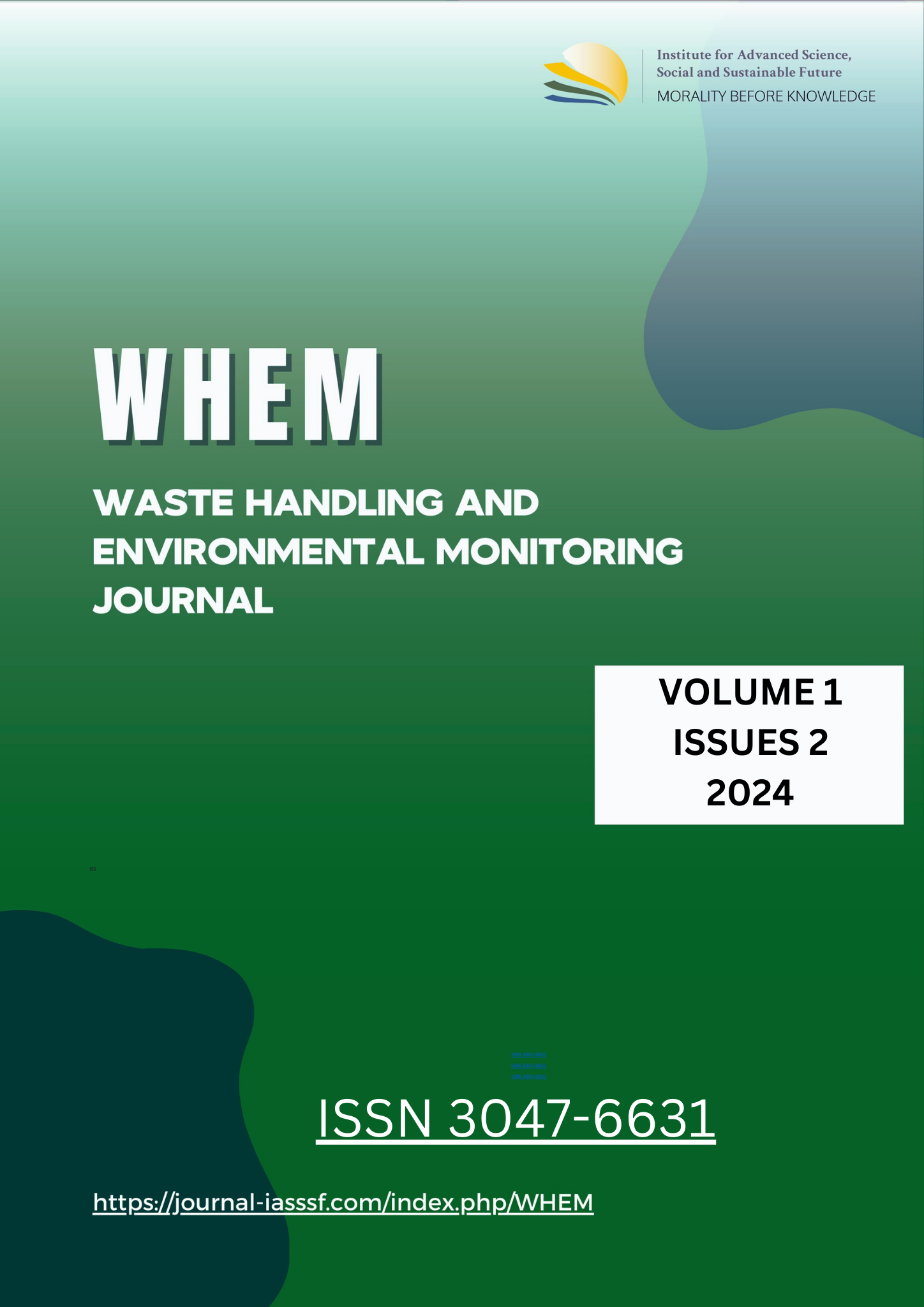Microplastic as an written composition in bottled water: Implications for waste management
DOI:
https://doi.org/10.61511/whem.v1i2.2024.1157Keywords:
microplastics, bottled water, pollutant, PCBs, metabolismAbstract
Background: Microplastics are the smallest particles of plastic measuring about 4.8 milliliters and are dangerous to the body due to the chemicals they contain, such as PCBs (Polychlorinated Biphenyls). Microplastics have been identified in various studies, both in aquatic and terrestrial environments, raising concerns about contamination in seafood, beverages (like beer), and more recently, bottled mineral water. Methods: This publication compiles and discusses currently available literature data on microplastic particles found in bottled mineral water. Findings: The discovery of microplastics in bottled mineral water highlights the widespread contamination of microplastics in consumable products, emphasizing the importance of water intake for supporting body metabolism. Conclusion: The identification of microplastics in bottled mineral water underscores the need for greater awareness of the dangers of microplastic contamination and its potential health risks. Novelty/Originality of this article: This article uniquely highlights the underexplored presence of microplastics in bottled mineral water, emphasizing the health risks associated with chemical contaminants like PCBs, and calls for increased awareness and regulatory measures to protect consumer safety.
References
Barnes, D. K., Galgani, F., Thompson, R. C., & Barlaz, M. (2009). Accumulation and fragmentation of plastic debris in global environments. Philosophical transactions of the royal society B: biological sciences, 364(1526), 1985-1998. https://doi.org/10.1098/rstb.2008.0205
Cindy, M. A. (2022). Estimasi Kandungan Mikroplastik dalam Barang Konsumsi Harian Manusia (2019). Katadata Media Network. https://databoks.katadata.co.id/datapublish/2022/03/31/air-minum-kemasan-mengandung-mikroplastik-ini- risetnya
Deng, Y., Zhang, Y., Lemos, B., & Ren, H. (2017). Tissue accumulation of microplastics in mice and biomarker responses suggest widespread health risks of exposure. Scientific reports, 7(1), 46687. https://doi.org/10.1038/srep46687
Edgina, A. (2021). PENGARUH PROMOSI DIGITAL, NILAI PELANGGAN, DAN RELIGIUSITAS TERHADAP LOYALITAS PELANGGAN AQUA (Studi Kasus Di Wilayah Kelurahan Penggilingan) (Doctoral dissertation, Sekolah Tinggi Ilmu Ekonomi Indonesia Jakarta).
Elkhatib, D., & Oyanedel-Craver, V. (2020). A critical review of extraction and identification methods of microplastics in wastewater and drinking water. Environmental Science & Technology, 54(12), 7037-7049. https://doi.org/10.1021/acs.est.9b06672
Faujiah, I. N., & Wahyuni, I. R. (2022, March). Kelimpahan dan karakteristik mikroplastik pada air minum serta potensi dampaknya terhadap kesehatan manusia. In Gunung Djati Conference Series (Vol. 7, pp. 89-95). https://conferences.uinsgd.ac.id/index.php/gdcs/article/view/609
Greeneration Foundation. (2021). Apa itu Mikroplastik. Retrieved October 27, 2022, from https://greeneration.org/publication/green-info/apa-itu-mikroplastik/
Ibeto, C. N., Enyoh, C. E., Ofomatah, A. C., Oguejiofor, L. A., Okafocha, T., & Okanya, V. (2021). Microplastics pollution indices of bottled water from South Eastern Nigeria. International Journal of Environmental Analytical Chemistry, 103(19), 8176-8195. https://doi.org/10.1080/03067319.2021.1982926
Kementrian Perindustrian. (2021). Kemenperin Pastikan Kemasan Galon Produk Air Minum Sesuai Aturan. Retrieved October 27, 2022, from https://kemenperin.go.id/artikel/21941/Kemenperin-Pastikan-Kemasan-Galon-Produk-Air-Minum-Sesuai-Aturan
Lusher, A., Hollman, P., & Mendoza-Hill, J. (2017). Microplastics in fisheries and aquaculture: status of knowledge on their occurrence and implications for aquatic organisms and food safety. FAO.
Lusher, A. L., Welden, N. A., Sobral, P., & Cole, M. (2020). Sampling, isolating and identifying microplastics ingested by fish and invertebrates. In Analysis of nanoplastics and microplastics in food. CRC Press.
Mason, S. A., Welch, V. G., & Neratko, J. (2018). Synthetic polymer contamination in bottled water. Frontiers in chemistry, 6, 389699. https://www.frontiersin.org/journals/chemistry/articles/10.3389/fchem.2018.00407/full?here%E2%80%99s_what_to_expect
Peraturan Menteri Kesehatan Republik Indonesia Nomor 492/MENKES/PER/IV/2010 Tentang Persyaratan Kualitas Air Minum.
P2PTM Menteri Kesehatan (2018). Berapa takaran normal air agar tidak kekurangan cairan dalam tubuh?. Retrieved October 27, 2022, from http://p2ptm.kemkes.go.id/preview/infografhic/berapa-takaran-normal-air-agar-tidak-kekurangan-cairan-dalam-tubuh
Roy, P. K., Hakkarainen, M., Varma, I. K., & Albertsson, A. C. (2011). Degradable polyethylene: fantasy or reality. Environmental science & technology, 45(10), 4217-4227. https://doi.org/10.1021/es104042f
Tjokro. G. (2021). Sejarah Perkembangan Air Mineral. Retrieved October 27, 2022, from https://grandtjokro.com/jakarta/blog/sejarah-perkembangan-air-mineral
Victoria, A. V. (2017). Kontaminasi mikroplastik di perairan tawar. Teknik Kimia ITB, (1-10).
Widianarko, Y. B., & Hantoro, I. (2018). Mikroplastik dalam Seafood dari Pantai Utara Jawa. https://repository.unika.ac.id/17537/
Yoshida, S., Hiraga, K., Takehana, T., Taniguchi, I., Yamaji, H., Maeda, Y., ... & Oda, K. (2016). A bacterium that degrades and assimilates poly (ethylene terephthalate). Science, 351(6278), 1196-1199. https://doi.org/10.1126/science.aad6359
Zhang, M., Li, J., Ding, H., Ding, J., Jiang, F., Ding, N. X., & Sun, C. (2020). Distribution characteristics and influencing factors of microplastics in urban tap water and water sources in Qingdao, China. Analytical Letters, 53(8), 1312-1327. https://doi.org/10.1080/00032719.2019.1705476
Downloads
Published
How to Cite
Issue
Section
Citation Check
License
Copyright (c) 2024 Waste Handling and Environmental Monitoring

This work is licensed under a Creative Commons Attribution 4.0 International License.

















